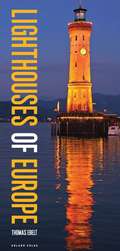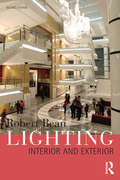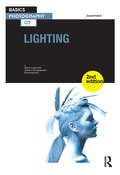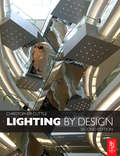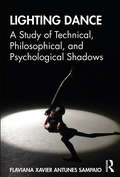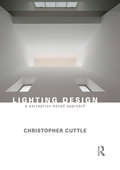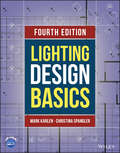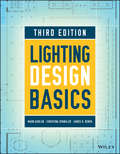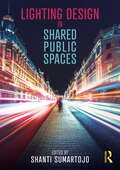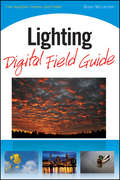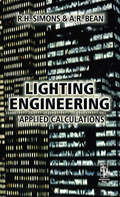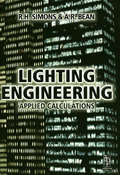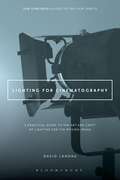- Table View
- List View
Lighthouses of Europe
by Thomas EbeltEurope has over 40,000 miles of coastline, stretching from the icy black waters of the Baltic to the deceptively serene Mediterranean. With many of Europe's countries bordering a sea, the need for lighthouses has spanned much of the continent for centuries.Lighthouses hold a perennial fascination for many of us - an indicator of danger, a beacon of the sea, laced with history and romance and a magnet for coastal walkers and visitors.Photographer Thomas Ebelt was charged with capturing beautiful imagery of the most stunning lighthouses for a lavish calendar, but on his journeys along Europe's coasts he found enough outstanding structures and dramatic landscapes to fill a calendar every year for a decade or more. This book is a collection of his finest photographs, from Poland and Estonia, via Iceland, around Scotland and England, and towards Malta and Sicily.Each lighthouse is accompanied by illuminating text about their history and construction. Specifications boxes provide information on position, identification features, height of the tower, height of the light, range and year of construction.
Lighthouses of Europe
by Thomas EbeltEurope has over 40,000 miles of coastline, stretching from the icy black waters of the Baltic to the deceptively serene Mediterranean. With many of Europe's countries bordering a sea, the need for lighthouses has spanned much of the continent for centuries.Lighthouses hold a perennial fascination for many of us - an indicator of danger, a beacon of the sea, laced with history and romance and a magnet for coastal walkers and visitors.Photographer Thomas Ebelt was charged with capturing beautiful imagery of the most stunning lighthouses for a lavish calendar, but on his journeys along Europe's coasts he found enough outstanding structures and dramatic landscapes to fill a calendar every year for a decade or more. This book is a collection of his finest photographs, from Poland and Estonia, via Iceland, around Scotland and England, and towards Malta and Sicily.Each lighthouse is accompanied by illuminating text about their history and construction. Specifications boxes provide information on position, identification features, height of the tower, height of the light, range and year of construction.
Lighting: Interior And Exterior
by Robert BeanThis comprehensive and practical guide takes you step-by-step through the core concepts and applications of architectural lighting. Now completely revised and updated for the second edition, this book: Includes all new information on the latest regulations and recommendations Provides special attention to the rapid development of LED lighting Considers the new CIE colour metric system Concludes each chapter with questions for the reader, together with inverted appropriate answers Features full colour throughout, for the first time, to support the text and aid the reader Covering a wide range of building types and external environments, this book shows how the concepts used in lighting design arise from the needs of the designer and user. These concepts are given a practical context to enable you to develop and improve your design skills, building up from the basics of how much light is needed and the role of shadows, to energy management and the calculations for daylighting, The author provides accessible, user-friendly explanations of technical information and specialist techniques intended for people who need to get to the heart of the subject as quickly as possible. An indispensible learning tool for students, and for professionals developing their skills, this handbook provides examples and exercises to help you acquire the understanding, knowledge and skill required for examinations and professional training purposes.
Lighting
by David PräkelUnderstanding light is fundamental to good photography. How any image is lit will change how the viewer sees and interprets the content. The second edition of Lighting teaches the theory and background of how light works, the different types of light and the rules it obeys. The book gives guidance on how to measure, control and use light for the best photographic exposure. With new images and case studies, this edition encourages a bolder and more innovative approach to the use of light in photography.
Lighting
by David PräkelUnderstanding light is fundamental to good photography. How any image is lit will change how the viewer sees and interprets the content. The second edition of Lighting teaches the theory and background of how light works, the different types of light and the rules it obeys. The book gives guidance on how to measure, control and use light for the best photographic exposure. With new images and case studies, this edition encourages a bolder and more innovative approach to the use of light in photography.
Lighting by Design
by Christopher CuttleLighting by Design provides guidance on where to find inspiration for lighting ideas, how to plan the technical detail and how to execute the plan to create safe, effective and beautiful schemes. Christopher Cuttle's unique three level approach uses Observation, Visualisation and Realisation as the means to achieve these aims. Cuttle is a well known figure in the UK, US and Australia and New Zealand, with a wealth of experience of both teaching and practice. This new edition is fully updated and produced in full colour with many new diagrams and photographs. It will be immensely useful to professional and student architects, interior designers and specialist lighting designers.
Lighting by Design
by Christopher CuttleLighting by Design provides guidance on where to find inspiration for lighting ideas, how to plan the technical detail and how to execute the plan to create safe, effective and beautiful schemes. Christopher Cuttle's unique three level approach uses Observation, Visualisation and Realisation as the means to achieve these aims. Cuttle is a well known figure in the UK, US and Australia and New Zealand, with a wealth of experience of both teaching and practice. This new edition is fully updated and produced in full colour with many new diagrams and photographs. It will be immensely useful to professional and student architects, interior designers and specialist lighting designers.
Lighting Dance: A Study of Technical, Philosophical, and Psychological Shadows
by Flaviana Xavier SampaioLighting Dance pioneers the discussion of the ability of lighting design to foreground shadow in dance performances. Through a series of experiments integrating light, shadow, and improvised dance movement, it highlights and analyses what it advances as an innovative expression of shadow in dance as an alternative to more conventional approaches to lighting design. Different art forms, such as painting, film, and dance pieces from Loie Fuller, the Russell Maliphant Dance Company, Elevenplay, Pilobolus, and the Tao Dance Theater served to inspire and contextualise the study. From lighting to psychology, from reviews to academic books, shadows are examined as a symbolic and manipulative entity. The book also presents the dance solo Sombreiro, which was created to echo the experiments with light, shadow, and movement aligned to an interpretation of cultural shadow (Jung 1954, in Samuels, Shorter, and Plaut 1986; Casement 2006; Ramos 2004; Stein 2004; and others). The historical development of lighting within dance practices is also outlined, providing a valuable resource for lighting designers, dance practitioners, and theatre goers interested in the visuality of dance performances.
Lighting Dance: A Study of Technical, Philosophical, and Psychological Shadows
by Flaviana Xavier SampaioLighting Dance pioneers the discussion of the ability of lighting design to foreground shadow in dance performances. Through a series of experiments integrating light, shadow, and improvised dance movement, it highlights and analyses what it advances as an innovative expression of shadow in dance as an alternative to more conventional approaches to lighting design. Different art forms, such as painting, film, and dance pieces from Loie Fuller, the Russell Maliphant Dance Company, Elevenplay, Pilobolus, and the Tao Dance Theater served to inspire and contextualise the study. From lighting to psychology, from reviews to academic books, shadows are examined as a symbolic and manipulative entity. The book also presents the dance solo Sombreiro, which was created to echo the experiments with light, shadow, and movement aligned to an interpretation of cultural shadow (Jung 1954, in Samuels, Shorter, and Plaut 1986; Casement 2006; Ramos 2004; Stein 2004; and others). The historical development of lighting within dance practices is also outlined, providing a valuable resource for lighting designers, dance practitioners, and theatre goers interested in the visuality of dance performances.
Lighting Design: A Perception-Based Approach
by Christopher CuttleBy reading this book, you will develop the skills to perceive a space and its contents in light, and be able to devise a layout of luminaires that will provide that lit appearance. Written by renowned lighting expert Christopher (Kit) Cuttle, the book: explains the difference between vision and perception, which is the distinction between providing lighting to make things visible, and providing it to influence the appearance of everything that is visible; demonstrates how lighting patterns generated by three-dimensional objects interacting with directional lighting are strongly influential upon how the visual perception process enables us to recognize object attributes, such as lightness, colourfulness, texture and gloss; reveals how a designer who understands the role of these lighting patterns in the perceptual process may employ them either to reveal, or to subdue, or to enhance the appearance of selected object attributes by creating appropriate spatial distributions of light; carefully explains calculational techniques and provides easy-to-use spreadsheets, so that layouts of lamps and luminaires are derived that can be relied upon to achieve the required illumination distributions. Practical lighting design involves devising three-dimensional light fields that create luminous hierarchies related to the visual significance of each element within a scene. By providing you with everything you need to develop a design concept - from the understanding of how lighting influences human perceptions of surroundings, through to engineering efficient and effective lighting solutions – Kit Cuttle instills in his readers a new-found confidence in lighting design.
Lighting Design: A Perception-Based Approach
by Christopher CuttleBy reading this book, you will develop the skills to perceive a space and its contents in light, and be able to devise a layout of luminaires that will provide that lit appearance. Written by renowned lighting expert Christopher (Kit) Cuttle, the book: explains the difference between vision and perception, which is the distinction between providing lighting to make things visible, and providing it to influence the appearance of everything that is visible; demonstrates how lighting patterns generated by three-dimensional objects interacting with directional lighting are strongly influential upon how the visual perception process enables us to recognize object attributes, such as lightness, colourfulness, texture and gloss; reveals how a designer who understands the role of these lighting patterns in the perceptual process may employ them either to reveal, or to subdue, or to enhance the appearance of selected object attributes by creating appropriate spatial distributions of light; carefully explains calculational techniques and provides easy-to-use spreadsheets, so that layouts of lamps and luminaires are derived that can be relied upon to achieve the required illumination distributions. Practical lighting design involves devising three-dimensional light fields that create luminous hierarchies related to the visual significance of each element within a scene. By providing you with everything you need to develop a design concept - from the understanding of how lighting influences human perceptions of surroundings, through to engineering efficient and effective lighting solutions – Kit Cuttle instills in his readers a new-found confidence in lighting design.
Lighting Design Basics
by Mark Karlen James R. BenyaLighting is a basic, yet difficult-to-master, element of interior design, and Lighting Design Basics provides the information you need in a concise, highly visual format. Two leading designers, both with decades of experience, offer straightforward coverage of concepts and techniques, and present realistic goals you can use as guides to creating simple, typical lighting designs and when collaborating with professional designers on more complex projects. Design scenarios for more than twenty different spaces illustrate real-world case studies for illuminating residential and commercial spaces, from kitchens to doctors' offices. Each scenario includes an in-depth rationale for the proposed solution, insightful lighting distribution diagrams, floor plans, and details for lighting installation and construction. In addition, exercises allow you to develop lighting design skills in preparation for working on actual projects, as well as the NCIDQ and NCARB exams. Packed with informative illustrations, Lighting Design Basics is an invaluable resource for students, as well as interior designers and architects studying for professional licensing exams.
Lighting Design Basics
by Mark Karlen Christina SpanglerLIGHTING DESIGN BASICS AN AUTHORITATIVE INTRODUCTION TO PROFESSIONAL LIGHTING DESIGN FOR ARCHITECTS, INTERIOR DESIGNERS, AND ENGINEERS Lighting is an essential component of any designed space, yet it is one of the most difficult right. Lighting Design Basics, 4th Edition provides a fundamental grounding in architectural lighting concepts, processes, and techniques that every student must master. The book offers a carefuly balanced combination of design and technology instruction and provides a great deal of graphic information, complete with plan, section, and three-dimensional drawings. The authors examine over 25 different design scenarios with in-depth rationales for proposed solutions, insightful distribution diagrams, floor plans, and details for lighting installation and construction. Immersive instruction on real-world settings accompanies practical guidance suitable for immediate application in everyday projects. Lighting can make or break any space, and design choices impact the cost and comfort of the building over the long term. Lighting Design Basics provides a critical foundation and prescriptive techniques to help future architects and interior designers make smart desing choices. This new edition provides readers with: A new chapter, entitled Light and Health, covering the physiological aspects of lighting design Updated LED technical content with coverage of light sources, luminaires, controls, quantity and quality of light, color rendition, and calculation software tutorials Explorations of industry codes and additional material on sustainable practices Thorough discussions of lighting in residences, workspaces, educational facilities, healthcare spaces, retail stores, and hospitality environments The basic skills required to become competent in the field, and prepare for the NCIDQ and NCARB exams Designed for undergraduate students in architecture and interior design, the latest edition of Lighting Design Basics is also valuable for working professionals in both fields who want to refresh their skills in lighting design and/or lighting technology
Lighting Design Basics
by Mark Karlen Christina SpanglerLIGHTING DESIGN BASICS AN AUTHORITATIVE INTRODUCTION TO PROFESSIONAL LIGHTING DESIGN FOR ARCHITECTS, INTERIOR DESIGNERS, AND ENGINEERS Lighting is an essential component of any designed space, yet it is one of the most difficult right. Lighting Design Basics, 4th Edition provides a fundamental grounding in architectural lighting concepts, processes, and techniques that every student must master. The book offers a carefuly balanced combination of design and technology instruction and provides a great deal of graphic information, complete with plan, section, and three-dimensional drawings. The authors examine over 25 different design scenarios with in-depth rationales for proposed solutions, insightful distribution diagrams, floor plans, and details for lighting installation and construction. Immersive instruction on real-world settings accompanies practical guidance suitable for immediate application in everyday projects. Lighting can make or break any space, and design choices impact the cost and comfort of the building over the long term. Lighting Design Basics provides a critical foundation and prescriptive techniques to help future architects and interior designers make smart desing choices. This new edition provides readers with: A new chapter, entitled Light and Health, covering the physiological aspects of lighting design Updated LED technical content with coverage of light sources, luminaires, controls, quantity and quality of light, color rendition, and calculation software tutorials Explorations of industry codes and additional material on sustainable practices Thorough discussions of lighting in residences, workspaces, educational facilities, healthcare spaces, retail stores, and hospitality environments The basic skills required to become competent in the field, and prepare for the NCIDQ and NCARB exams Designed for undergraduate students in architecture and interior design, the latest edition of Lighting Design Basics is also valuable for working professionals in both fields who want to refresh their skills in lighting design and/or lighting technology
Lighting Design Basics
by Mark Karlen Christina Spangler James R. BenyaA visual, real-world guide to professional lighting design Lighting Design Basics is the essential guide to this basic, but difficult-to-master aspect of interior design. Offering fundamental concepts and prescriptive techniques in a highly visual format, this book provides clear, practical guidance on utilizing the latest in lighting techniques and technology to showcase a space without sacrificing utility. Covering more than 25 different design scenarios with in-depth rationale for proposed solutions, this book provides insightful distribution diagrams, floor plans, and details for lighting installation and construction. Real-world case studies illustrate lighting design in residential, commercial, healthcare, education, and hospitality settings, and skill-building exercises offer practice for real-world projects as well as NCIDQ and NCARB exam preparation. This new third edition includes new instructor support materials, coverage of computer calculation software, and in-depth discussion on the latest in LED lighting. Lighting is changing, both in the technology itself, and in the way a designer must approach it. This book provides immersive instruction through real-world settings, and practical guidance suited for immediate application in everyday projects. Get up-to-date on the latest methods and technology for lighting design Examine more than 25 design scenarios for different types of spaces Complete exercises to hone your skills or prepare for the NCIDQ or NCARB Create simple lighting designs and collaborate with architects on complex projects Lighting can make or break a space. Improper lighting lends a space an uncomfortable feel, can induce headaches or eyestrain, and can even be hazardous—but thoughtfully designed and executed lighting adds that extra element so often missing from typical spaces. Lighting Design Basics shows you how to elevate any space through the fundamental tools and concepts of professional lighting design.
Lighting Design Basics
by Mark Karlen Christina Spangler James R. BenyaA visual, real-world guide to professional lighting design Lighting Design Basics is the essential guide to this basic, but difficult-to-master aspect of interior design. Offering fundamental concepts and prescriptive techniques in a highly visual format, this book provides clear, practical guidance on utilizing the latest in lighting techniques and technology to showcase a space without sacrificing utility. Covering more than 25 different design scenarios with in-depth rationale for proposed solutions, this book provides insightful distribution diagrams, floor plans, and details for lighting installation and construction. Real-world case studies illustrate lighting design in residential, commercial, healthcare, education, and hospitality settings, and skill-building exercises offer practice for real-world projects as well as NCIDQ and NCARB exam preparation. This new third edition includes new instructor support materials, coverage of computer calculation software, and in-depth discussion on the latest in LED lighting. Lighting is changing, both in the technology itself, and in the way a designer must approach it. This book provides immersive instruction through real-world settings, and practical guidance suited for immediate application in everyday projects. Get up-to-date on the latest methods and technology for lighting design Examine more than 25 design scenarios for different types of spaces Complete exercises to hone your skills or prepare for the NCIDQ or NCARB Create simple lighting designs and collaborate with architects on complex projects Lighting can make or break a space. Improper lighting lends a space an uncomfortable feel, can induce headaches or eyestrain, and can even be hazardous—but thoughtfully designed and executed lighting adds that extra element so often missing from typical spaces. Lighting Design Basics shows you how to elevate any space through the fundamental tools and concepts of professional lighting design.
Lighting Design in Shared Public Spaces
by Shanti SumartojoThis book advocates an approach to lighting design that focuses on how people experience illumination. Lighting Design in Shared Public Spaces contextualises light, dark and lighting design within the settings, sensations, ideas and imaginaries that form our understandings of ourselves and the world around us. The chapters in this collection bring a new perspective to lighting design, arguing for an approach that addresses how lighting is experienced, understood and valued by people. Across a range of new case studies from Australia, Germany, Denmark, and the United Kingdom, the authors account for lighting design’s crucial role in shaping our dynamic and messy experiential worlds. With many turning to innovative ethnographic methodologies, they powerfully demonstrate how feelings of comfort, safety, security, vulnerability, care and well-being can configure in and through how people experience and manipulate light and dark. By focusing on how lighting is improvised, arranged, avoided and composed in relation to the people and things it acts upon, the book advances understandings of lighting design by showing how improved experiences of the built environment can result from more sensitive and context-specific illumination. The book is intended for social scientists who are interested in the lit or sensory world, as well as designers, architects, urban planners and others concerned with how the experience of light, dark and lighting might be both better understood and implemented in our shared public spaces.
Lighting Design in Shared Public Spaces
by Shanti SumartojoThis book advocates an approach to lighting design that focuses on how people experience illumination. Lighting Design in Shared Public Spaces contextualises light, dark and lighting design within the settings, sensations, ideas and imaginaries that form our understandings of ourselves and the world around us. The chapters in this collection bring a new perspective to lighting design, arguing for an approach that addresses how lighting is experienced, understood and valued by people. Across a range of new case studies from Australia, Germany, Denmark, and the United Kingdom, the authors account for lighting design’s crucial role in shaping our dynamic and messy experiential worlds. With many turning to innovative ethnographic methodologies, they powerfully demonstrate how feelings of comfort, safety, security, vulnerability, care and well-being can configure in and through how people experience and manipulate light and dark. By focusing on how lighting is improvised, arranged, avoided and composed in relation to the people and things it acts upon, the book advances understandings of lighting design by showing how improved experiences of the built environment can result from more sensitive and context-specific illumination. The book is intended for social scientists who are interested in the lit or sensory world, as well as designers, architects, urban planners and others concerned with how the experience of light, dark and lighting might be both better understood and implemented in our shared public spaces.
Lighting Digital Field Guide (Digital Field Guide #237)
by Brian McLernonEssential lighting guide for users of compact cameras and dSLRs One of the most important aspects of photography is lighting, but getting the lighting right is tricky. When should you use flash? Are a camera’s automatic settings dependable? Should you use reflectors or diffusers and where do you place them? This handy, portable reference will show you when, where, and how to create and capture perfect light, every time. The book includes a color checker card to help you maintain true color, as well as examples of stunningly-lit photos of people, wildlife, and landscapes to inspire you. Walks you through the essentials of lighting for digital photography Helps beginning and intermediate photographers leave the safety of automatic settings and confidently control lighting themselves Shows how to evaluate natural light, decide when to use flash, and how and when to use diffusers or reflectors Includes a tear-out color checker card to help you maintain true color in your photographs Comes in the handy, portable Digital Field Guides size, perfect for camera bags Create and capture the perfect lighting every time, with Lighting Digital Field Guide!
Lighting Digital Field Guide (Digital Field Guide)
by Brian McLernonEssential lighting guide for users of compact cameras and dSLRs One of the most important aspects of photography is lighting, but getting the lighting right is tricky. When should you use flash? Are a camera’s automatic settings dependable? Should you use reflectors or diffusers and where do you place them? This handy, portable reference will show you when, where, and how to create and capture perfect light, every time. The book includes a color checker card to help you maintain true color, as well as examples of stunningly-lit photos of people, wildlife, and landscapes to inspire you. Walks you through the essentials of lighting for digital photography Helps beginning and intermediate photographers leave the safety of automatic settings and confidently control lighting themselves Shows how to evaluate natural light, decide when to use flash, and how and when to use diffusers or reflectors Includes a tear-out color checker card to help you maintain true color in your photographs Comes in the handy, portable Digital Field Guides size, perfect for camera bags Create and capture the perfect lighting every time, with Lighting Digital Field Guide!
Lighting Engineering: Applied Calculations
by R. H. Simons A.R. Bean'Lighting Engineering: Applied Calculations' describes the mathematical background to the calculation techniques used in lighting engineering and links them to the applications with which they are used. The fundamentals of flux and illuminance, colour, measurement and optical design are covered in detail. There are detailed discussions of specific applications, including interior lighting, road lighting, tunnel lighting, floodlighting and emergency lighting. The authors have used their years of experience to provide guidance for common mistakes and useful techniques including worked examples and case studies.The last decade has seen the universal application of personal computers to lighting engineering on a day-to-day basis. Many calculations that were previously impracticable are therefore now easily accessible to any engineer or designer who has access to an appropriate computer program. However, a grasp of the underlying calculation principles is still necessary in order to utilise these technologies to the full. Written by two of the leading authorities on this subject, 'Lighting Engineering' is essential reading for practising lighting engineers, designers and architects, and students in the field of lighting.
Lighting Engineering: Applied Calculations
by R. H. Simons A.R. Bean'Lighting Engineering: Applied Calculations' describes the mathematical background to the calculation techniques used in lighting engineering and links them to the applications with which they are used. The fundamentals of flux and illuminance, colour, measurement and optical design are covered in detail. There are detailed discussions of specific applications, including interior lighting, road lighting, tunnel lighting, floodlighting and emergency lighting. The authors have used their years of experience to provide guidance for common mistakes and useful techniques including worked examples and case studies.The last decade has seen the universal application of personal computers to lighting engineering on a day-to-day basis. Many calculations that were previously impracticable are therefore now easily accessible to any engineer or designer who has access to an appropriate computer program. However, a grasp of the underlying calculation principles is still necessary in order to utilise these technologies to the full. Written by two of the leading authorities on this subject, 'Lighting Engineering' is essential reading for practising lighting engineers, designers and architects, and students in the field of lighting.
Lighting for Animation: The Art of Visual Storytelling
by Jasmine Katatikarn Michael TanzilloLighting for Animation is designed with one goal in mind - to make you a better artist. Over the course of the book, Jasmine Katatikarn and Michael Tanzillo (Senior Lighting TDs, Blue Sky Studios) will train your eye to analyze your work more critically, and teach you approaches and techniques to improve your craft. Focusing on the main philosophies and core concepts utilized by industry professionals, this book builds the foundation for a successful career as a lighting artist in visual effects and computer animation. Inside you’ll find in-depth instruction on: • Creating mood and storytelling through lighting • Using light to create visual shaping • Directing the viewer’s eye with light and color • Gathering and utilizing reference images • Successfully lighting and rendering workflows • Render layers and how they can be used most effectively • Specific lighting scenarios, including character lighting, environment lighting, and lighting an animated sequence • Material properties and their work with lighting • Compositing techniques essential for a lighter • A guide on how to start your career and achieve success as a lighting artist This book is not designed to teach software packages—there are websites, instructional manuals, online demos, and traditional courses available to teach you how to operate specific computer programs. That type of training will teach you how to create an image; this book will teach you the technical skills you need to make that image beautiful. Key Features Stunning examples from a variety of films serve to inspire and inform your creative choices. Unique approach focuses on using lighting as a storytelling tool, rather than just telling you which buttons to press. Comprehensive companion website contains lighting exercises, assets, challenges, and further resources to help you expand your skillset.
Lighting for Animation: The Art of Visual Storytelling
by Jasmine Katatikarn Michael TanzilloLighting for Animation is designed with one goal in mind - to make you a better artist. Over the course of the book, Jasmine Katatikarn and Michael Tanzillo (Senior Lighting TDs, Blue Sky Studios) will train your eye to analyze your work more critically, and teach you approaches and techniques to improve your craft. Focusing on the main philosophies and core concepts utilized by industry professionals, this book builds the foundation for a successful career as a lighting artist in visual effects and computer animation. Inside you’ll find in-depth instruction on: • Creating mood and storytelling through lighting • Using light to create visual shaping • Directing the viewer’s eye with light and color • Gathering and utilizing reference images • Successfully lighting and rendering workflows • Render layers and how they can be used most effectively • Specific lighting scenarios, including character lighting, environment lighting, and lighting an animated sequence • Material properties and their work with lighting • Compositing techniques essential for a lighter • A guide on how to start your career and achieve success as a lighting artist This book is not designed to teach software packages—there are websites, instructional manuals, online demos, and traditional courses available to teach you how to operate specific computer programs. That type of training will teach you how to create an image; this book will teach you the technical skills you need to make that image beautiful. Key Features Stunning examples from a variety of films serve to inspire and inform your creative choices. Unique approach focuses on using lighting as a storytelling tool, rather than just telling you which buttons to press. Comprehensive companion website contains lighting exercises, assets, challenges, and further resources to help you expand your skillset.
Lighting for Cinematography: A Practical Guide to the Art and Craft of Lighting for the Moving Image (The CineTech Guides to the Film Crafts)
by David LandauWe can't shoot good pictures without good lighting, no matter how good the newest cameras are. Shooting under available light gives exposure, but lacks depth, contrast, contour, atmosphere and often separation. The story could be the greatest in the world, but if the lighting is poor viewers will assume it's amateurish and not take it seriously. Feature films and TV shows, commercials and industrial videos, reality TV and documentaries, even event and wedding videos tell stories. Good lighting can make them look real, while real lighting often makes them look fake.Lighting for Cinematography, the first volume in the new CineTech Guides to the Film Crafts series, is the indispensable guide for film and video lighting. Written by veteran gaffer and cinematographer David Landau, the book helps the reader create lighting that supports the emotional moment of the scene, contributes to the atmosphere of the story and augments an artistic style. Structured to mimic a 14 week semester, the chapters cover such things as lighting for movement, working with windows, night lighting, lighting the three plains of action and non-fiction lighting. Every chapter includes stills, lighting diagrams and key advice from professionals in the field, as well as lighting exercises to help the reader put into practice what was covered.www.lightingforcinematography.com
